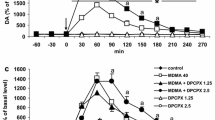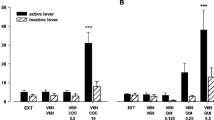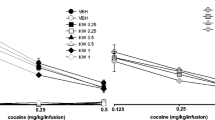Abstract
Carbamazepine (CBZ), an anticonvulsant with psychotropic and anti-pain properties, has been reported to displace ligands at adenosine binding sites. This paper describes biochemical and behavioural studies in rodents comparing CBZ to the adenosine agonistsl-phenylisopropyl-adenosine (l-PIA) and N-ethylcarboxamido-adenosine (NECA), the new antagonists PD116,948 and PD115,199 which are also relatively A1 and A2 specific respectively, and the mixed antagonists theophylline and caffeine, attempting to determine functional correlates of the binding studies. Changes in cAMP synthesis and behavioural syndromes produced by the drugs, alone and in combination, were monitored. Classification of the observed effects in terms of A1 and A2 activity was complex, probably due to functional interactions between A1 and A2 subtypes. Nevertheless, it was found that chronic CBZ administration (0.25% in food for 3 days, followed by 0.5% for 11 days) produced a pattern of interaction identical to that of PD115,199 (10–100 mg/kg IP). Thus, both treatments attenuated the behavioural syndrome produced byl-PIA (0.1 or 0.5 mg/kg SC), but did not affect that produced by NECA (0.03 mg/kg SC). CBZ mildly increased hypoactivity after clonidine (0.2 mg/kg IP) which was used as a control. By contrast, the A1 antagonist PD116,948 (0.1–10 mg/kg IP) antagonised both behavioural syndromes. Similarly in the biochemical experiments both chronic CBZ and PD115,199 (10–100 µM) reduced stimulation of cAMP synthesis byl-PIA (confirming that this is mediated by A2 receptors), while only basal cAMP synthesis was affected by PD116,948 (10 µM) and theophylline (60 µM). Acute CBZ did not alterl-PIA stimulated cAMP synthesis at concentrations up to 100 µM (i.e. within the therapeutic plasma concentration). Chronic CBZ did not alter motor activity stimulated by caffeine (5 mg/kg IP). These results suggest that PD155,199 and PD116,948 may be useful in defining the functions of adenosine receptor subtypes, and that chronic CBZ appears to functionally down-regulate A2 receptors.
Similar content being viewed by others
References
Bruns RF, Lu GH, Pugsley TA (1986) Characterisation of the A2 adenosine receptor labelled by [3H]NECA in rat striatal membranes. Mol Pharmacol 29:331–346
Bruns RF, Fergus JH, Badger EW, Bristol J, Santay LA, Hartman JD, Hays SJ, Huang CC (1987a) Binding of the A1-selective adenosine antagonist 8-cyclopentyl-1,-3-dipropylxanthine to rat brain membranes. Naunyn-Schmiedeberg's Arch Pharmacol 335:59–63
Bruns RF, Fergus JH, Badger EW, Bristol JA, Santay LA, Hays SJ (1987b) PD115,199: an antagonist ligand for adenosine A2 receptors. Naunyn-Schmiedeberg's Arch Pharmacol 335:64–69
Clark M, Post RM (1989) Carbamazepine, but not caffeine, is highly selective for adenosine A1 binding sites. Eur J Pharmacol 169:399–401
Coffin VL, Carney JM (1986) Effects of selected analogs of adenosine on schedule-controlled behaviour in rats. Neuropharmacology 25:1141–1147
Daval JL, Deckert J, Weiss SRB, Post RM, Marangos PJ (1989) Upregulation of adenosine A1 receptors and forskolin binding sites following chronic treatment with caffeine or carbamazepine: a quantitative autoradiographic study. Epilepsia 30:26–33
Donaldson J, Brown AM, Hill SJ (1988) Influence of rolipram on the cyclic 3′,5′-adenosine monophosphate response to histamine and adenosine in slices of guinea-pig cerebral cortex. Biochem Pharmacol 37:715–723
Drew GM, Gower AJ, Marriott AS (1979)α 2-adrenoceptors mediate clonidine-induced sedation in the rat. Br J Pharmacol 67:133–141
Dunwiddie TV, Worth T (1982) Sedative and anticonvulsant effects of adenosine analogs in mouse and rat. J Pharmacol Exp Ther 220:70–76
Dunwiddie TV, Fredholm BB (1989) Adenosine A1 receptors inhibit adenylate cyclase activity and neurotransmitter release and hyperpolarise pyramidal neurones in rat hippocampus. J Pharmacol Exp Ther 249:31–37
Elphick M (1988) The clinical uses and pharmacology of carbamazepine in psychiatry. Int Clin Psychopharmacol 3:185–203
Elphick M (1989) Effects of carbamazepine on dopamine function in rodents. Psychopharmacology (in press)
Elphick M, Anderson SMP, Hallis KF, Grahame-Smith DG (1989a) The effects of carbamazepine on 5-hydroxytryptamine function in rodents. Psychopharmacology (in press)
Elphick M, Yang JK, Cowen PJ (1989b) The effects of carbamazepine on 5-hydroxytryptamine and dopamine-mediated neuroendocrine function in volunteers. Arch Gen Psychiatry (in press)
Fergus JH, Bruns RF, Badger EW, Bristol JA, Hartman JD, Santay LA, Hays SJ, Huang CC (1986) Adenosine receptor binding of the A1-selective antagonist [3H] PD116,948. Fed Proc 44(801): Abstr. 3758
Fredholm BB, Dunwiddie TV (1988) How does adenosine inhibit transmitter release? TIPS 9:130–134
Fredholm BB, Jonzon B, Lindgren E, Lindström K (1982) Adenosine receptors mediating cyclic AMP production in the rat hippocampus. J Neurochem 39:165–175
Fredholm BB, Jonzon B, Lindström K (1986) Effect of adenosine receptor agonists and other compounds on cyclic AMP accumulation in forskolin-treated hippocampal slices. Naunyn-Schmiedeberg's Arch Pharmacol 332:173–178
Fujiwara Y, Sato M, Otsuki S (1986) Interaction of carbamazepine and other drugs with adenosine (A1 and A2) receptors. Psychopharmacology 90:332–335
Godfrey PP, McClue JJ, Young MM, Heal DJ (1988) 5-Hydroxytryptamine-stimulated inositol phospholipid hydrolysis in the mouse cortex has pharmacological characteristics compatible with mediation via 5-HT2 receptors but this response does not reflect altered 5-HT2 function after 5–7-dihydroxytryptamine lesioning or repeated antidepressant treatments. J Neurochem 50:730–738
Gurden MF, Bhalla P, Kennedy I (1987) Is PD116,948 a selective adenosine A1 receptor antagonist? Br J Pharmacol 92:788P
Haleen SJ, Steffen RP, Hamilton HW (1987) PD116,948, a highly selective A1 adenosine receptor antagonist. Life Sci 40:555–561
Heal DJ, Acagi H, Bowdler JM, Green AR (1981) Repeated ECS attenuates clonidine-induced hypoactivity in rodents. Eur J Pharmacol 75:231–237
Lewin E, Bleck V (1977) Cyclic AMP accumulation in cerebral cortical slices. Effect of carbamazepine, phenobarbital and phenytoin. Epilepsia 18:237–242
Marangos PJ, Post RM, Patel J, Zander K, Parma A, Weiss SR (1983) Specific and potent interactions of carbamazepine with brain adenosine receptors. Eur J Pharmacol 93:175–182
Marangos PJ, Weiss SR, Montgomery P, Patel J, Narang PK, Cappabianca AM, Post RM (1985) Chronic carbamazepine treatment increases brain adenosine receptors. Epilepsia 26:493–498
Marangos PJ, Montgomery P, Weiss SRB, Patel J, Post RM (1987a) Persistent upregulation of brain adenosine receptors in response to chronic carbamazepine treatment. Clin Neuropharmacol 10:443–448
Marangos PJ, Patel J, Smith KD, Post RM (1987b) Adenosine antagonist properties of carbamazepine. Epilepsia 28:387–394
Onali P, Olianas MC, Bunse B (1988) Evidence that adenosine A2 and dopamine autoreceptors antagonistically regulate tyrosine hydroxylase activity in rat striatal synaptosomes. Brain Res 456:302–309
Palmer GC, Jones DJ, Medina MA, Savinoha WB (1979) Anticonvulsant drug actions on in vitro and in vivo levels of cyclic AMP in the mouse brain. Epilepsia 20:95–104
Phillis JW (1984) Interactions of the anticonvulsants diphenylhydantoin and carbamazepine with adenosine on cerebral cortical neurons. Epilepsia 25:765–772
Popoli P, Benedetti M, Scotti de Carolis A (1988) Anticonvulsant activity of carbamazepine and N6-l-phenylisopropyladenosine in rabbits. Relationship to adenosine receptors in central nervous system. Pharmacol Biochem Behav 29:533–539
Porter NM, Radulovacki M, Green RD (1988) Desensitization of adenosine and dopamine receptors in rat brain after treatment with adenosine analogs. J Pharmacol Exp Ther 244:218–225
Ribeiro JA, Sebastiao AM (1988) Subtypes of adenosine receptors. TIPS 9:279–280
Skerritt JH, Davies LP, Johnston GAR (1983a) Interactions of the anticonvulsant carbamazepine with adenosine receptors 1. Neurochemical studies. Epilepsia 24:634–642
Skerritt JH, Johnston GAR, Chow SC (1983b) Interactions of the anticonvulsant carbamazepine with adenosine receptors 2. Pharmacological studies. Epilepsia 24:643–650
Spealman RD, Coffin VL (1986) Behavioural effects of adenosine analogs in squirrel monkeys: relation to adenosine A2 receptors. Psychopharmacology 90:419–421
Stone TW (1988) Interactions of carbamazepine, chlormethiazole and pento barbitone with adenosine on hippocampal slices. Gen Pharmacol 19:67–72
Van Calker D, Muller M, Hamprecht B (1979) Adenosine regulates via two different types of receptors, the accumulation of cyclic AMP in cultured brain cells. J Neurochem 33:999–1005
Weir RL, Padgett W, Daly JW, Anderson SM (1984) Interaction of anticonvulsant drugs with adenosine receptors in the central nervous system. Epilepsia 25:492–498
Author information
Authors and Affiliations
Rights and permissions
About this article
Cite this article
Elphick, M., Taghavi, Z., Powell, T. et al. Chronic carbamazepine down-regulates adenosine A2 receptors: studies with the putative selective adenosine antagonists PD115,199 and PD116,948. Psychopharmacology 100, 522–529 (1990). https://doi.org/10.1007/BF02244006
Received:
Revised:
Issue Date:
DOI: https://doi.org/10.1007/BF02244006




